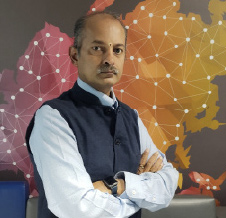
In the vast and chaotic digital ecosystem of modern India, an insidious battle is being waged daily—not with guns or bombs, but through meticulously crafted narratives, doctored images, and armies of automated accounts. As the world's largest democracy navigates a rapidly shifting geopolitical landscape, India has become a prime target for sophisticated disinformation campaigns designed to inflame tensions and erode public trust in institutions.
These are not random instances of misinformation but highly coordinated operations, executed with military precision. Recent analyses reveal a structured eight-phase strategy—akin to a battle plan—that malicious actors follow to spread falsehoods. Understanding this framework is crucial to recognizing how disinformation is weaponized and used to exploit societal fault lines.
How Foreign Powers Exploit India's Digital Landscape
Two of India's key geopolitical rivals—China and Pakistan—have been consistently deploying digital deception tactics to undermine India's stability. These campaigns are designed not just to spread misinformation but to shape international narratives and sow discord within the country.
China’s Disinformation Playbook
China has engaged in systematic information warfare across multiple fronts, leveraging state media, bot networks, and fake accounts to amplify misleading narratives. Some of its key strategies include:
- Undermining India's G-20 Presidency by questioning its financial capability.
- Portraying India as the aggressor in the 2020 Galwan Valley clash.
- Criticizing India's COVID-19 response to tarnish its global reputation.
- Spreading diplomatic discord in cases like the Canada dispute and Dalai Lama issue.
- Pushing territorial claims over Arunachal Pradesh with doctored maps.
- Discrediting India’s economic rise to discourage foreign investment.
- Supporting Pakistan’s stance on Kashmir to sustain global anti-India sentiment.
- Highlighting internal unrest, such as the Manipur violence, to paint India as unstable.
These efforts rely on an intricate ecosystem of manipulated media, social media amplification, and suppression of counter-narratives.
Pakistan’s Disinformation Tactics
Pakistan, too, has waged digital campaigns to damage India’s global standing. Their playbook involves:
- Using fake videos to depict India as an authoritarian state, particularly during farmer protests.
- Spreading doctored images of alleged human rights violations in Kashmir.
- Denying India’s successes, such as the Balakot airstrike, through fabricated "evidence."
- Exploiting communal tensions, particularly around the Citizenship Amendment Act (CAA) protests.
- Circulating economic instability narratives to deter investors.
- Mocking India’s military with edited footage, particularly after the 2019 aerial skirmish involving Wing Commander Abhinandan.
By leveraging networks of fake accounts, cloned media outlets, and viral hashtags, these campaigns influence global perception and weaken India’s strategic credibility.
The Disinformation Kill Chain: A Step-by-Step Breakdown
To fully understand how these campaigns operate, it’s essential to examine their lifecycle. The methodology follows a structured "Disinformation Kill Chain," a concept borrowed from military warfare strategies.
1. RECON (Identifying Vulnerabilities)
Malicious actors pinpoint societal fault lines—religious, regional, and economic. The CAA protests, for example, were weaponized by amplifying fears within Muslim communities. Similarly, the 2020-21 farmers' protests were manipulated to deepen urban-rural divides.
2. DESIGN (Crafting Narratives)
False narratives are strategically developed, blending partial truths with misinformation. A common tactic during the farmer protests was spreading exaggerated claims that the government planned to abolish the Minimum Support Price (MSP) system.
3. BUILD (Creating Infrastructure for Deception)
Fake accounts, cloned news portals, and automated bot networks are quietly established—often lying dormant until activated. These assets can appear authentic for months before suddenly pivoting to disinformation campaigns.
4. SEED (Soft Launch of Disinformation)
False narratives are first circulated in closed digital spaces like WhatsApp groups and Telegram channels. During the early COVID-19 pandemic, manipulated statistics about India’s response initially surfaced in local community groups before reaching mainstream platforms.
5. COPY (Replicating Across Formats)
A single piece of false information is repackaged into text posts, memes, videos, and infographics, ensuring maximum reach and making fact-checking more difficult.
6. AMPLIFY (Boosting Visibility)
Bots, influencers, and even unsuspecting individuals contribute to making false claims trend. International celebrities, for instance, unwittingly amplified misinformation during the farmer protests, lending legitimacy to manipulated narratives.
7. CONTROL (Suppressing Opposition)
Efforts are made to discredit fact-checkers and create an illusion of consensus. Fake grassroots movements give the impression that certain narratives have overwhelming public support.
8. EFFECT (Real-World Consequences)
The ultimate goal is to drive tangible impacts—ranging from riots and diplomatic tensions to policy reversals influenced by manufactured outrage. Studies indicate that districts exposed to high volumes of disinformation experience increased communal violence and protests.
Case Study: Border Tensions and Digital Manipulation
During the 2023 India-China border tensions, a well-orchestrated campaign flooded social media with fabricated videos of military movements. Within 72 hours, protests erupted, and diplomatic relations suffered a setback. Investigations later uncovered a network of over 2,000 coordinated accounts operating from overseas servers.
Fighting Back: India’s Countermeasures
India has not remained idle in the face of these threats. Several initiatives have been launched to combat disinformation:
- Digital India Media Literacy Initiative – Teaching millions of students critical thinking skills to assess online content.
- AI-Driven Fact-Checking Tools – Improving the detection of synthetic media and fake news.
- Legislative Measures – The IT Rules 2021 and the upcoming Digital India Act aim to hold digital intermediaries accountable for misinformation.
- Social Media Crackdowns – Platforms have ramped up their efforts, removing millions of fake accounts annually.
However, challenges persist, particularly in moderating content across India's diverse linguistic landscape. Rural and elderly populations remain highly vulnerable, and AI-generated deepfakes will only make distinguishing truth from falsehood more difficult.
At its core, this is a fight for the integrity of information. When people lose the ability to differentiate fact from fiction, democracy itself is at risk. India’s response to these challenges will serve as a test case for democracies worldwide. The question is whether our institutions and civil society can evolve fast enough to keep pace with the ever-advancing machinery of deception.
*Brijesh Singh is a senior IPS officer and an author, his latest book is “The Cloud Chariot” (Penguin). Views are personal.
See What’s Next in Tech With the Fast Forward Newsletter
Tweets From @varindiamag
Nothing to see here - yet
When they Tweet, their Tweets will show up here.




























